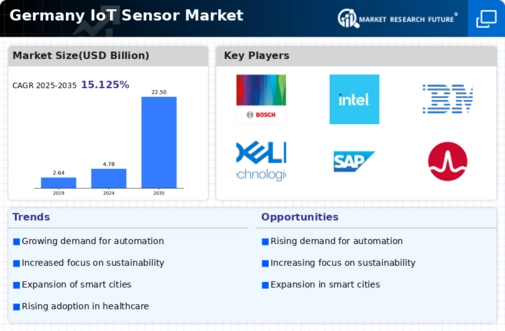Emergence of Smart Agriculture
The agricultural sector in Germany is increasingly adopting IoT technologies, which is a significant driver for the iot sensor market. Smart agriculture practices, such as precision farming, rely heavily on sensors to monitor soil conditions, crop health, and weather patterns. This trend is expected to grow as farmers seek to optimize yields and reduce resource consumption. The German agricultural technology market is anticipated to reach €10 billion by 2025, with a notable share attributed to sensor technologies. By utilizing IoT sensors, farmers can make data-driven decisions that enhance productivity and sustainability. This shift towards smart agriculture not only supports food security but also contributes to the overall growth of the iot sensor market.
Rising Demand for Smart Cities
The push towards smart city initiatives in Germany is driving the iot sensor market. As urban areas increasingly adopt technology to enhance infrastructure and services, the demand for sensors that monitor traffic, air quality, and energy consumption is surging. According to recent studies, the smart city market in Germany is projected to reach €100 billion by 2025, with a significant portion allocated to sensor technologies. This trend indicates a robust growth trajectory for the iot sensor market, as municipalities seek to improve efficiency and sustainability. The integration of sensors into urban planning not only enhances the quality of life for residents but also provides valuable data for city management, thereby fostering a more connected and responsive urban environment.
Growth of the Healthcare Sector
The healthcare sector in Germany is witnessing a transformation driven by the integration of IoT technologies, which is significantly influencing the iot sensor market. With an increasing focus on remote patient monitoring and telehealth solutions, the demand for medical sensors is on the rise. The German healthcare market is projected to reach €500 billion by 2025, with a substantial portion dedicated to innovative technologies, including IoT sensors. These devices enable continuous health monitoring, data collection, and improved patient outcomes. As healthcare providers seek to enhance service delivery and operational efficiency, the iot sensor market is poised for growth, driven by the need for reliable and accurate health monitoring solutions.
Advancements in Industrial Automation
Germany's strong industrial base is a key driver for the iot sensor market, particularly in the realm of automation. The manufacturing sector is increasingly leveraging sensors to optimize production processes, reduce downtime, and enhance product quality. Reports suggest that the industrial automation market in Germany is expected to grow at a CAGR of 8% through 2025, with sensors playing a pivotal role in this transformation. The implementation of smart sensors allows for real-time monitoring and data collection, which is essential for predictive maintenance and operational efficiency. As industries continue to embrace the Internet of Things, the demand for advanced sensor technologies is likely to escalate, further propelling the growth of the iot sensor market.
Regulatory Support for Environmental Sustainability
The German government is actively promoting environmental sustainability, which significantly impacts the iot sensor market. Regulations aimed at reducing carbon emissions and enhancing energy efficiency are encouraging businesses to adopt sensor technologies for monitoring and compliance. For instance, the German Climate Action Program aims to reduce greenhouse gas emissions by 55% by 2030, creating a favorable environment for the deployment of environmental sensors. This regulatory framework not only drives innovation in sensor technology but also fosters partnerships between public and private sectors. As companies seek to align with these regulations, the iot sensor market is likely to experience increased demand for solutions that facilitate environmental monitoring and reporting.
























Leave a Comment